Multilayer diffusion networks as a tool to assess the structure and functioning of fine grain sub‐specific plant–pollinator networks
IF 3.1
2区 环境科学与生态学
Q2 ECOLOGY
引用次数: 0
Abstract
Interaction networks are a widely used tool to understand the dynamics of plant–pollinator ecological communities. However, while most mutualistic networks have been defined at the species level, ecological processes such as pollination take place at different scales, including the individual or patch levels. Yet, current approaches studying fine‐grain sub‐specific plant–pollinator networks only account for interactions among nodes belonging to a single plant species due to the conceptual and mathematical limitations of modeling simultaneously several plant species each composed of several nodes. Here, we introduce a multilayer diffusion network framework that allows modeling simple diffusion processes between nodes pertaining to the same or different layers (i.e. species). It is designed to depict from the network structure the potential conspecific and heterospecific pollen flows among plant individuals or patches. This potential pollen flow is modeled as a transport‐like system, in which pollen grain movements are represented as random‐walkers that diffuse on an ensemble of bipartite layers of conspecific plants and their shared pollinators. We exemplify this physical conceptualization using a dataset of nine fine‐grain sub‐specific plant–pollinator networks from a Mediterranean grassland of annual plants, where plant nodes represent groups of conspecifics within patches of 1 m以多层扩散网络为工具,评估细粒亚特异性植物授粉者网络的结构和功能
交互网络是了解植物-传粉昆虫生态群落动态的一种广泛应用的工具。然而,虽然大多数互作网络都是在物种水平上定义的,但授粉等生态过程发生在不同的尺度上,包括个体或斑块水平。然而,由于同时模拟由多个节点组成的多个植物物种在概念和数学上的局限性,目前研究细粒度亚特异性植物-传粉昆虫网络的方法只考虑了属于单一植物物种的节点之间的相互作用。在此,我们介绍一种多层扩散网络框架,该框架可模拟同层或不同层(即物种)节点之间的简单扩散过程。它旨在通过网络结构描述植物个体或斑块之间潜在的同种和异种花粉流。这种潜在的花粉流被模拟为一个类似运输的系统,其中花粉粒的运动被表示为随机行走,在由同种植物及其共同授粉者组成的双方格层集合上扩散。我们利用地中海草地一年生植物的九个细粒度亚特异性植物-传粉者网络数据集对这一物理概念进行了举例说明,其中植物节点代表 1 平方米斑块内的同种植物群。扩散网络显示,授粉者有效地连接了相同和不同植物物种的斑块集,形成了一种模块化结构。有趣的是,网络结构的不同属性,如同种植物花粉到达概率和植物嵌入的同种植物子图数量,对不同植物物种的种子生产至关重要。我们提供了一套简单而稳健的指标来计算潜在的花粉流,并将网络生态学缩小到个体或斑块层面的功能特性,而大多数生态过程都是在个体或斑块层面进行的,从而推进了跨尺度物种丰富群落的描述和解释。
本文章由计算机程序翻译,如有差异,请以英文原文为准。
求助全文
约1分钟内获得全文
求助全文
来源期刊

Oikos
环境科学-生态学
CiteScore
6.20
自引率
5.90%
发文量
152
审稿时长
6-12 weeks
期刊介绍:
Oikos publishes original and innovative research on all aspects of ecology, defined as organism-environment interactions at various spatiotemporal scales, so including macroecology and evolutionary ecology. Emphasis is on theoretical and empirical work aimed at generalization and synthesis across taxa, systems and ecological disciplines. Papers can contribute to new developments in ecology by reporting novel theory or critical empirical results, and "synthesis" can include developing new theory, tests of general hypotheses, or bringing together established or emerging areas of ecology. Confirming or extending the established literature, by for example showing results that are novel for a new taxon, or purely applied research, is given low priority.
 求助内容:
求助内容: 应助结果提醒方式:
应助结果提醒方式:


